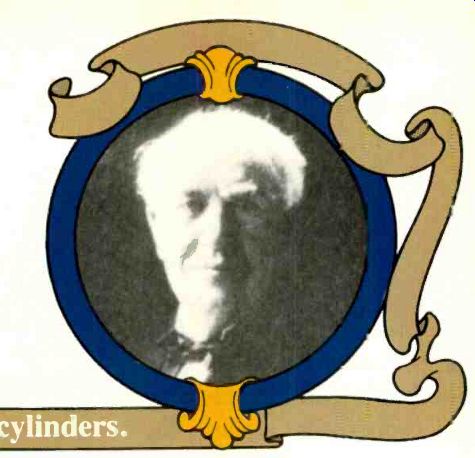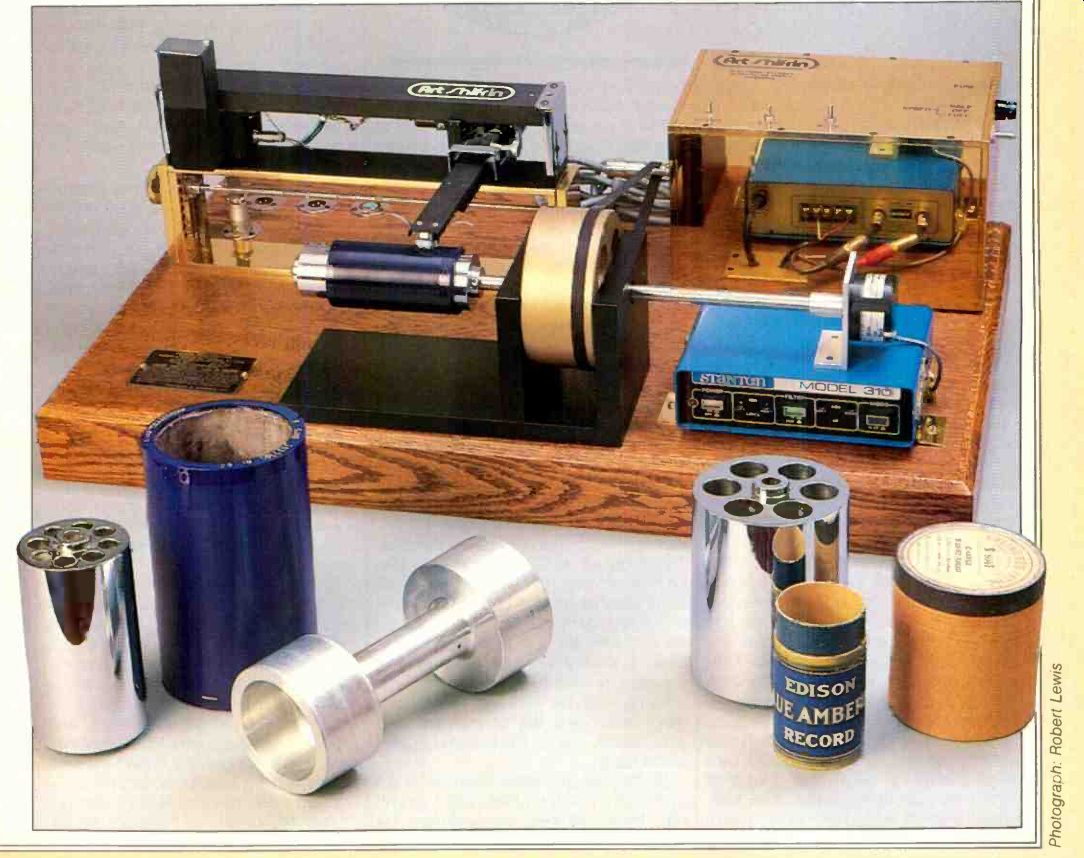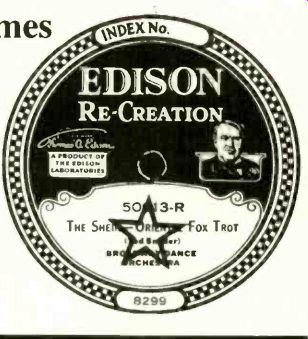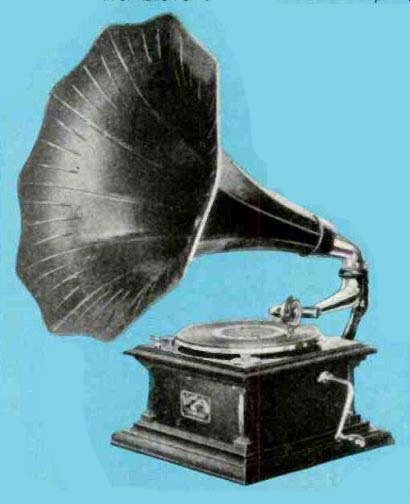Re-recording engineer Art Shifrin uses sophisticated methods to play antique cylinders.
by FRED PETRAS


Shown playing a standard wax cylinder (c. 1906), Shifrin's
machine uses a variety of changeable mandrels to play standard and nonstandard
cylinders. In foreground, from left, are a Pathé Salon mandrel, Edison Kinetophone
cylinder and mandrel, Concert mandrel, Edison Blue Amberol cylinder tube
(c. 19121929), and a Salon cylinder tube.
While up-to-date audio buffs eagerly explore the state-of-the-art digital sound of the Compact Disc, a surprisingly large clique of music lovers still explores the birth -of -the art sounds of the Edison cylinder and Berliner disc.
This early -fi contingent of old phonograph and record collectors is not, however, made up only of oldsters seeking yesteryear's Edisons, Victrolas and Graphophones to revive happy moments associated with their youth. It encompasses as many buffs under 40 years of age as over 40. These enthusiasts see early phonographic technology as quite sophisticated, and they often view it as a challenge. That challenge is to extract every nuance of sound still contained in the grooves of ancient discs and cylinders. This clique might best be described as "tweakers," kin of those present-day audiophiles who go to extremes to achieve sonic bliss.

Some "old tyme" tweakers attain their goals by acquiring two or more units of a certain cylinder or disc phonograph, tearing them down, then creating a single "new" machine from the best or least -worn parts of both originals. Other enthusiasts will selectively replace an old phonograph's operating elements, using parts from a variety of sources that cater to sound archeologists, to get "mint" equipment whose optimized reproducing capabilities can satisfy their goals.
But the more determined tweaker goes beyond refurbishing or reconstructing original equipment. He believes that vintage acoustic phono hardware, no matter how good its condition, cannot bring out all of the sounds in cylinder or lateral -cut disc grooves. Instead, he applies modern technology to the old-using a current phono cartridge, for example, instead of a mechanical "sound box" to recreate the original recorded sound. He may also employ a variety of filtering, noise -reduction and equalization devices to further improve the results. He will also re-record the results for posterity (and for convenience) on cassette or reel-to-reel tape.
One of the most determined and best-known of early -sound enthusiasts is Arthur Shifrin of Douglaston, New York, a sound technician internationally known for his restorations of early disc, cylinder, film and magnetic recordings. To achieve proper reproduction of cylinders, Shifrin has developed a truly deluxe playback system using sophisticated modern technology and equipment. Shifrin's Electronic Cylinder System, originally created for his own personal and professional use, is now also made to order in a variety of custom configurations for educational institutions, sound archivists, historical record producers and for serious--and well-heeled-hobbyists. Selling for about $15,000 in its basic version, Shifrin's system is comprised of four handsomely constructed components: A thick, solid hardwood base; a motor and control housing; a drive assembly, and a radial -tracking tonearm.
The arm is a modified Rabco SL8-E which can track cylinders up to 6 inches long, of any groove pitch or speed.
Drive screws, such as those used in old cylinder phonos, are avoided by this mechanism's design. The arm is modified to accommodate the faster tracking progression needed, since most cylinders have a faster tracking rate than do the LP discs for which the SL8-E was originally designed. Shifrin's unit also features controls for lift, mute, and servo override. The last modification provides an electrical means of riding the stylus past damage -locked grooves.
The motor housing contains the tonearm controls and a heavy-duty hysteresis -synchronous motor. The drive shaft is equipped with a stepped pulley having three diameters, typically for 120-, 144and 160 -rpm speeds.
Speeds are manually selected by moving the drive belt to these positions.
Shifrin explained that there are many out -of -round cylinders which would ordinarily be considered unplayable because they cause pickups to bounce uncontrollably at normal playing speeds. He has gotten around this problem by using an electrically switched motor which provides half speed operation for each of the set's standard rpm rates. By tracking the warped recordings at slower speeds, pickup bouncing is eliminated. Tapes of this reproducing procedure are played back at twice the speed at which they were recorded. The half speed technique also avoids the use of heavy tracking forces which can harm the old grooves and distort the sound.
The drive assembly is comprised of a precision-ground half-inch-diameter shaft, stanchions, a brass flywheel, and a mandrel. The latter is specially designed to accommodate warped as well as normal cylinders. Access to the mandrel, which revolves on precision ball bearings, is via an open end, so cylinders can be mounted and removed without the impediment of "gates" like those on original Edison players.
Shifrin's system employs a Stanton 310 preamp with any moving -magnet cartridge. Two equalization curves are provided, linear and a modified RIAA roll-off. The latter is generally used for listening applications, while the former is intended for use with additional signal processors.
Options include convertibility for cylinders of other than standard diameter.
This requires additional mandrels and an arm elevator mechanism. The standard drive motor can be replaced with a d.c.-servo model for digital speed confirmation and variable speed operation. Specially sized and shaped styli are also available. A cabinet/console housing can be ordered to complement or replace the counter -top version, which has a 2 1/2-inch -thick fine wood base.
Shifrin recommends that once an optimum stylus for a particular cylinder has been chosen, the cylinder be promptly taped. He feels that it is prudent to make any further adjustments to the sound from a master tape that has been recorded "flat." "Thus," he explains, "rare recordings won't be jeopardized by repeated playing and handling. This procedure is especially pertinent to wax cylinders, which can be precariously soft or brittle." Shifrin claims a speed accuracy of 99.8% for his instrument. Its wow and flutter is less than 0.08% for the highest speed, 0.1% for the low speed. It weighs in at around 50 pounds.
When he debuted the first commercial version of his system, Shifrin explained that he had developed it "on the premise that most cylinders were better recorded than most people presume, and certainly better than the caliber of the equipment originally used to play them back. Anyone who has heard such recordings reproduced on my system, with appropriate auxiliary noise -reduction equipment, has been amazed at their clarity and sonic impact." Shifrin admits that his pricey ensemble does not have "the antique charm of an old external -horn phonograph." But, conversely, he feels early phonographs cannot reproduce old recordings satisfactorily. "Even when functioning optimally, they impart speed fluctuations to the sound. If you tape from their horns through microphones, the mikes pick up unwanted harmonic resonances caused by the horns.
Room noises, as well as mechanical sounds made by the phonograph, are also picked up by the mikes and superimposed on the original recorded sounds. The technique of installing a new pickup on an old reproducer does not solve the problem of speed fluctuations. You also need half -speed playing capabilities."

---------- Collectors of early-fi gear are sometimes surprised to find
out how sophisticated and good sounding these old recordings were.
Shifrin also cautions that severe rumble and other sonic disturbances can result from interactions between a modern, sensitive pickup and the old, imprecise, or worn drive mechanisms.
"My instrument also has the unique ability to accommodate the multiplicity of diameters, lengths, speeds and groove pitches usually found in cylinders. It is not generally known that the quality of most acoustical recordings--both disc and cylinder types-was finer than the caliber of playback equipment available at the time. My system enables the modern user to extract superior fidelity from cylinders, with less noise and distortion than previously thought possible." The first production model of the Shifrin Electronic Cylinder System was sold to the Rodgers and Hammerstein Archives of Recorded Sound, New York Public Library at Lincoln Center. It is being used there to transfer a large part of the Archives' collection to tape to preserve irreplaceable historical vocal and musical performances and to make them easily accessible to students and others interested in hearing them. Another of his machines is doing extensive duty at the Swedish Radio Company, in Stockholm, Sweden, optimally processing a "phenomenal" collection of cylinders from the 1890s for preservation on tape. Shifrin's own personal machine has been used in a variety of sonic projects. "The most significant was to reproduce the synchronous film soundtracks recorded by Edison on cylinders [71/2 inches long by 4 1/4 inches in diameter] in 1912 and 1913 called 'Kinetophones,' " he says.
Also significant was a project involving home -cut cylinders made by the Mellon family in the mid -1890s. (Andrew Mellon was a noted financier and industrialist, and Secretary of the Treasury from 1921 to 1932.) Says Shifrin, "These cylinders had been kicked around a lot as the family moved here and there. Existing family members wanted to capture the voices of their ancestors and to listen to some of the conversations that had been recorded at various times at family gatherings.
Despite the horrendously bad condition of the cylinders, with scratches, cracks, warps and mold -rot, we were able to make them really understandable and to effectively tape them. One of the cylinders contained the sounds of a party at the Mellon home on New Year's Day, 1895." A (Editor's Note: Shifrin's current "hot" interests are the early sound films from Biophon, Kinetophone, Cameraphone, Movietone, Cinephone, Vitaphone, Eugene Lauste, Orlando Kellum, et al. He will appreciate receiving any information or artifacts. We will forward them to him via the magazine: Art Shifrin, c/o Audio, 1515 Broadway, New York, N.Y. 10036.)
--------------
Sampler of Sources
If you want to get involved in old phonograph and record collecting, you'll find the pickings fairly substantial, even at this late date. If your discretionary dollars are limited, what you'll need is a lot of time and patience and determination to seek out the hardware and software within the parameters of your budget. If money is no object, you can save a lot of effort in acquiring low -tech "goodies" by merely heading for any one of dozens of sources catering to old phono and record _collectors and gratifying your desires on the spot.
Herewith are a very few sources that collectors might find worthy of checking out. (Note: A complete up-to-date list would be impossible, given the ebb and flow of the collector's marketplace.) Antique Phonograph Monthly ( 502 East 17th St., Brooklyn, N.Y. 11226). A 16 -page magazine containing wide-ranging information on old phonos and records in the form of feature articles, old ad reproductions, book reviews, etc., plus a classified section that lists a variety of goods and services available to collectors. Ten issue subscription is $10.
Kastlemusick, Inc. ( 901 Washington St, Wilmington, Del. 19801). This publisher's most recent directory (1982/1983) contains over 2,500 names and addresses of sources of equipment and records, plus collectors' clubs and associations, among other valuable information. Price, $12.95 postpaid. Kastlemusick also publishes a monthly bulletin chock full of information of interest to collectors. Sample copy, $1.00. Neal's Antiques ( 23 Waldo Ave., Bloomfield, N.J. 07003). Formerly operated by Al Gerichten, known as the "dean" of Edison phonography, it is now run' by his son Neal, who also mans a complete machine shop to make exact replacements of phono parts no longer available. Sells and repairs all types of phonographs, and stocks a selection of records and accessories.
The Antique Phonograph Shop (300 Jericho Turnpike, Floral Park, N.Y. 11001). Carries 'all makes of phonographs and offers repairs,; parts and accessories. Also sells cylinder and disc records.
Charlie Hummel ( 61 Laurel Dr., Wayne, N.J. 07470). Sells and repairs old phonographs and also LI deals in old records and related phonographia. Shifrin considers him truly expert and completely trustworthy. F.P.

-------------
(Audio magazine, May 1984)
Also see:
London Letter: Edison Updated, Awards Reinstated (May 1985)
= = = =